Google Nexus 5 Review
by Brian Klug on December 5, 2013 8:00 AM EST- Posted in
- Smartphones
- LG
- Android
- Mobile
- Snapdragon 800
- Android 4.4
- Nexus 5
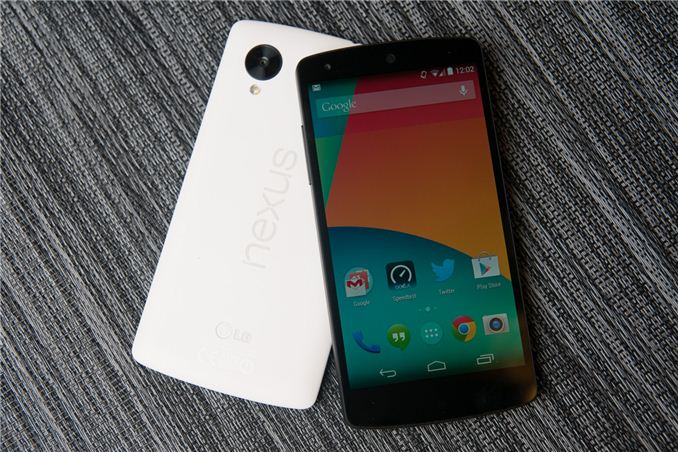
Each year, Google picks a silicon vendor, a hardware partner, and releases a new version of Android running on top of them. The result is a Nexus phone, and for five iterations now that process has repeated, resulting in a smartphone that’s the purest expression of Google’s vision for its mobile platform. Today we’re looking at the Nexus 5.
Nexus 5, as its name makes obvious, is the latest generation of Google’s line of Nexus smartphones, and also is topped by a 5-inch display. While the Nexus program originally started only for smartphones, we’ve seen Google since extend the program to include a 7-inch and 10-inch tablet form factor, as well as a line of accessories. In recent years, we’ve seen Nexus go from being part enthusiast curiosity and development device, to a brand tailored for consumers looking for the latest and greatest the Android platform has to offer at a killer price.
Last generation we saw the Nexus 4, a device that was essentially an LG Optimus G for T-Mobile in different clothing and priced at a competitive price, yet still included the latest and greatest silicon from Qualcomm with APQ8064 (S4 Pro). For Nexus 5, Google has once again gone with hardware partner LG and silicon vendor Qualcomm, this time with a phone that’s somewhat analogous to the LG G2 (but not exactly the same platform) and using the latest and greatest MSM8974 (Snapdragon 800) silicon.
Let’s start with the hardware, since that’s the normal flow for a review. The Nexus 4 bore a lot of superficial similarities to the Optimus G, including a glass back with laser etched design below its surface, the same display, banding, and materials. The Nexus 5 on the other hand doesn’t bear any similarities to the G2, with its buttons on the back, narrow bezel, rounded backside, and glossy plastic. Instead, the Nexus 5’s design borrows much of its industrial design language from the Nexus 7 (2013), with the slightly rounded top and bottom, landscape “nexus” logo on the rear, and large radius curves all around the side. The Nexus 5 and 7 share almost the same shape and profile, and in the case of the black Nexus 5, same rubberized soft touch material on the back and sides. If you scaled down the Nexus 7 design you’d get something which is awfully close to the Nexus 5.
The result is a two-device family that feels like it was made by the same company, and it’s really the first time Google has aligned its industrial design in such a sweeping fashion, in this case even across two different hardware partners. I guess you could make the argument that with the exception of the Nexus 10, Google has eliminated any industrial design fragmentation and finally crafted some hardware design language that it owns for itself.
Google sampled us first a black Nexus 5, and later a white Nexus 5 at my request so I could check out the material differences I saw some discussion about. It’s true that there are some differences between the two devices. For starters, the white device has a backside which eschews the soft touch material, instead giving the polymer-backed device a rougher, textured feeling. The absence of soft touch continues to the edge, which is glossy black plastic instead of the rubberized material, and comes with protective plastic installed over it by default. On the front the only visible difference between white and black is a white colored earpiece, the rest of the bezel around the display is still black.
I’m reminded of the split between the white and black Note 3 with the Nexus 5, which also only includes rubberized material on the black model. I find myself preferring the feeling of the white model instead, but it’s really just a story of personal taste. No doubt the absence of soft touch on the white material is to prevent staining from hand oils or other dyes as the device ages. I don’t find that the absence of soft touch on the white model makes it any more difficult to hold or grip onto, the negative-angled bezel really does help the Nexus 5 fit into the hand securely.
Although the Nexus 5 is a close cousin, it doesn’t adopt the button arrangement from the G2, instead locating the volume and standby buttons in a normal place. Volume rocker ends up on the left, power on the right side.
Likewise earpiece is on top and microUSB is at the bottom of the device. What’s unique about the Nexus 5 buttons is the material of those buttons – they’re ceramic, not polycarbonate. The result is that they’re sharp and instantly locatable with the brush of a finger, it’s a subtle thing that does feel different. The only complaint I have is that they do seem to rattle slightly inside their cutouts. I can affirm that the white model seems to have less rattle, but I’m not entirely sure how much of that is intrinsic to the color difference and absence of soft touch.
Also on the back is the Nexus 5’s oversized camera cutout, which is slightly raised from the surface around it. It’s fair to say that the Nexus 5 does have a camera bump, something that’s not going away soon in all but the most iconic devices. When I first saw the oversized ring, I assumed it was just a design motif, and others later speculated it was for a line of magnetically-attachable add on lenses. To date none of those have materialized, and upon further consideration having magnets next to the VCM (voice coil motor) electromagnetic focus and OIS mechanism could complicate things. In any case, at present the oversized ring around the camera aperture is a unique design point rather than something which serves a function.
The only real negative about the camera cutout is that dust seems to be able to get into the crack surrounding it and the cover glass. It’s something unfortunate about the Nexus 5’s design in general – there are cracks that show dirt quickly, for example the backside has a seam around the edge where dust seems to intrude. It obviously doesn’t change the Nexus 5’s function, but immediately starts looking dirty on the black model, and part of why given both side by side I prefer the white one.
I think pragmatic describes the Nexus 5 design quite well, since honestly the design doesn’t try to be flashy just for the sake of differentiation or make any crazy materials choices on the outside. There are subtle design features which definitely are appreciated, however, like the negative angle to the edge which makes the device easy to grip, those ceramic buttons, and the continuity of design language from the Nexus 7 of course. Materials are a big differentiator between devices right now, and again the Nexus 5 is relatively pragmatic with its choice of polymer, but does deserve kudos for not going with the slick, glossy-surfaced material still preferred by Korean handset makers.
The Nexus 5 feels well made and precision crafted, but I can’t shake the feeling that Nexus 4 felt more like a standout design of its own. The Nexus 5 seems a lot more, well, traditional, without the rounded-glass edges, chrome ring, or pattern below the glass on the back (which I still maintain contained some kind of encoded message). The reality is that Google made a lot of decisions with Nexus to optimize for cost, and that the Nexus 5’s design is actually quite differentiated given the price.
The Nexus 5 adds a lot over its predecessor – larger 1080p display, newer silicon, 802.11ac, better camera with OIS, and of course LTE connectivity, all while getting minimally more expensive than its predecessor. It’s almost unnecessary to say that the Nexus 5 is obviously the best Nexus phone yet.
| Physical Comparison | ||||
| LG G2 | Samsung Galaxy Nexus (GSM/UMTS) | LG Nexus 4 | LG Nexus 5 | |
| Height | 138.5 mm | 135.5 mm | 133.9 mm | 137.84 mm |
| Width | 70.9 mm | 67.94 mm | 68.7 mm | 69.17 mm |
| Depth | 9.14 mm | 8.94 mm | 9.1 mm | 8.59 mm |
| Weight | 143 g | 135 g | 139 g | 130 g |
| CPU |
2.26 GHz MSM8974 (Quad Core Krait 400) |
1.2 GHz OMAP 4460 (Dual Core Cortex A9) | 1.5 GHz APQ8064 (Quad Core Krait) |
2.26 GHz MSM8974 (Quad Core Krait 400) |
| GPU | Adreno 330 | PowerVR SGX 540 @ 304 MHz | Adreno 320 | Adreno 330 |
| RAM | 2 GB LPDDR3 | 1 GB LPDDR2 | 2 GB LPDDR2 | 2 GB LPDDR3 |
| NAND | 16/32 GB NAND | 16/32 GB NAND | 8/16 GB NAND | 16/32 GB NAND |
| Camera | 13 MP with OIS and Flash (Rear Facing) 2.1 MP Full HD (Front Facing) | 5 MP with AF/LED Flash, 1080p30 video recording, 1.3 MP front facing | 8 MP with AF/LED Flash, 1.3 MP front facing | 8 MP with OIS, AF, LED flash, 1.3 MP front facing |
| Screen | 5.2-inch 1920x1080 Full HD IPS LCD | 4.65" 1280x720 SAMOLED HD | 4.7" 1280x768 HD IPS+ LCD | 4.95" 1920x1080 HD IPS LCD |
| Battery | Internal 11.4 Whr | Removable 6.48 Whr | Internal 8.0 Whr | Internal 8.74 Whr |
Google also sent over one of the Nexus 5 bumper cases, which really isn’t so much bumper as it is, well, all around case. The Nexus 4 had bumpers that wrapped around the edge, but left the glass back exposed, much like the iPhone 4/4S era bumpers.
Nexus 5’s bumper case covers up everything but the oversized camera aperture on the back. The red one I got doesn’t seem to be silicone but some other thermoplastic.
At $35 it’s a bit on the pricey side, but it does fit the device nicely and get the job done with some cool neon colors that spice up the Nexus 5.


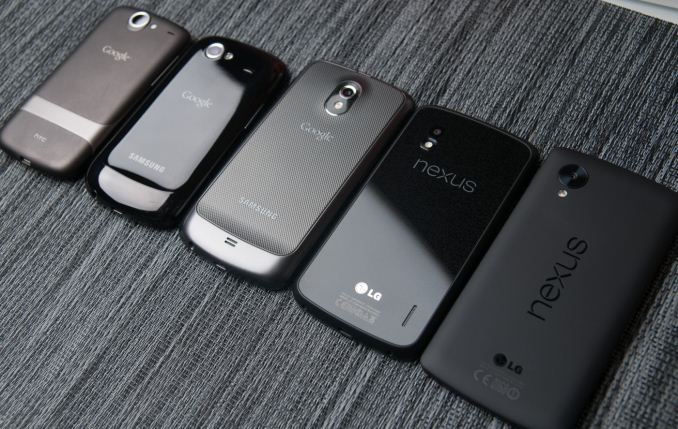
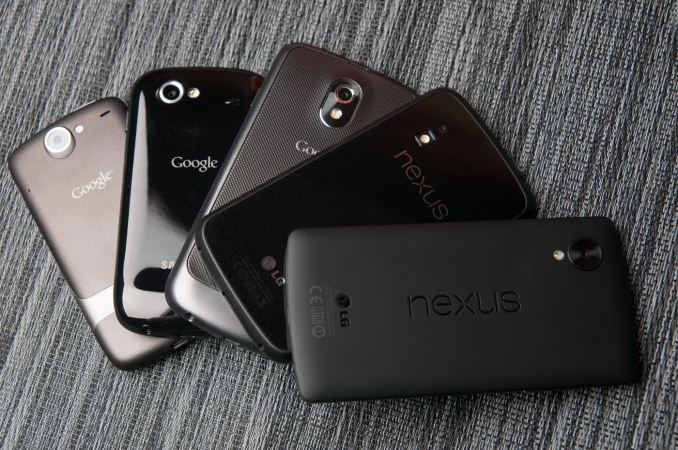
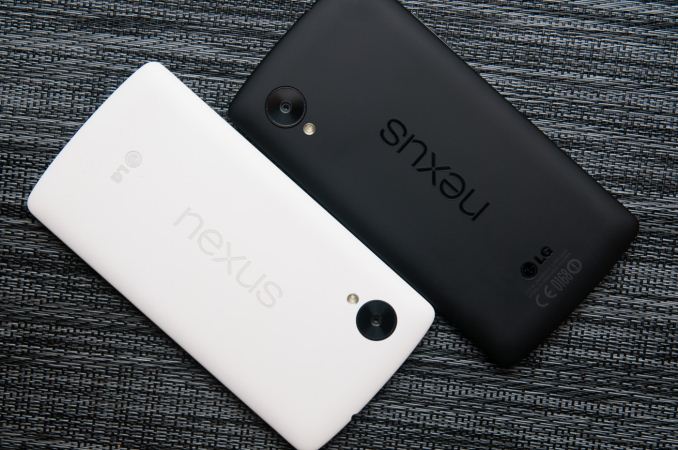
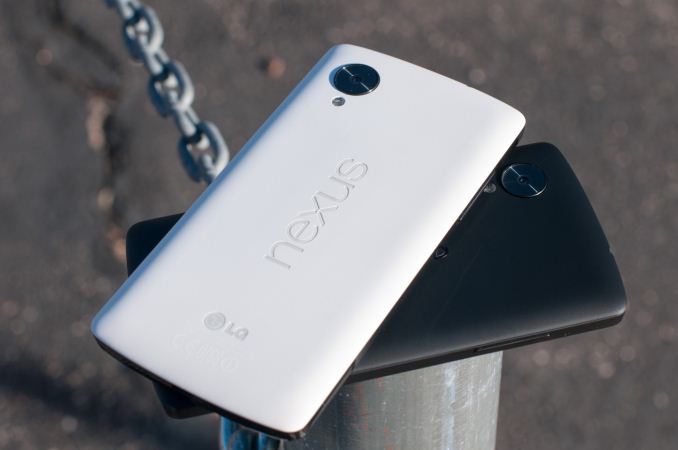
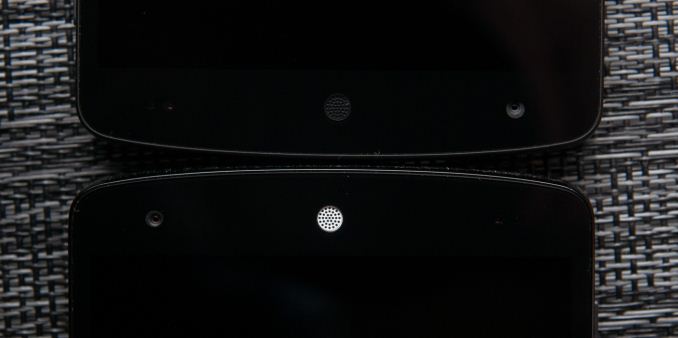
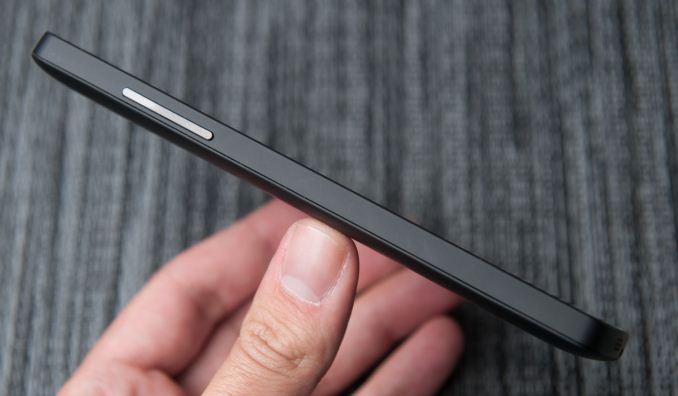
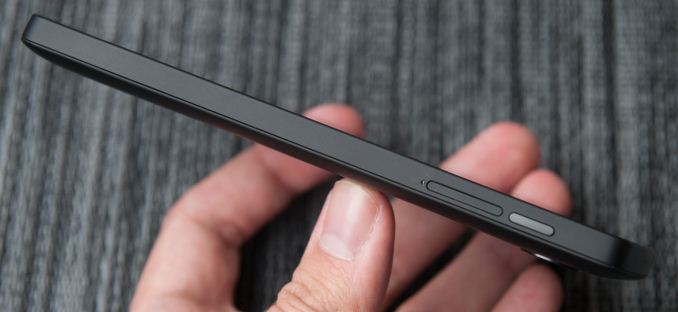








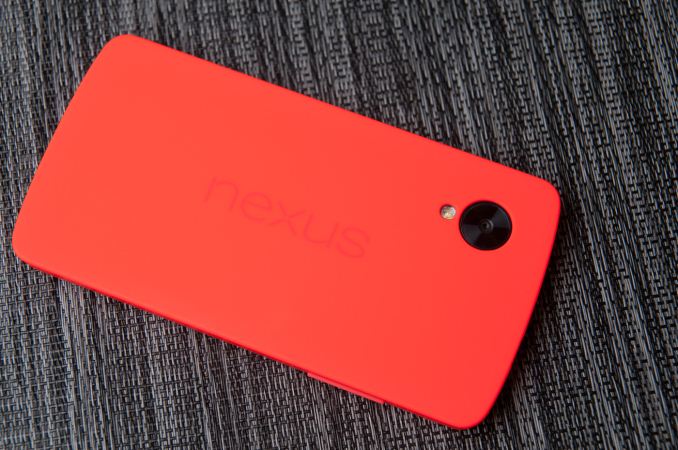
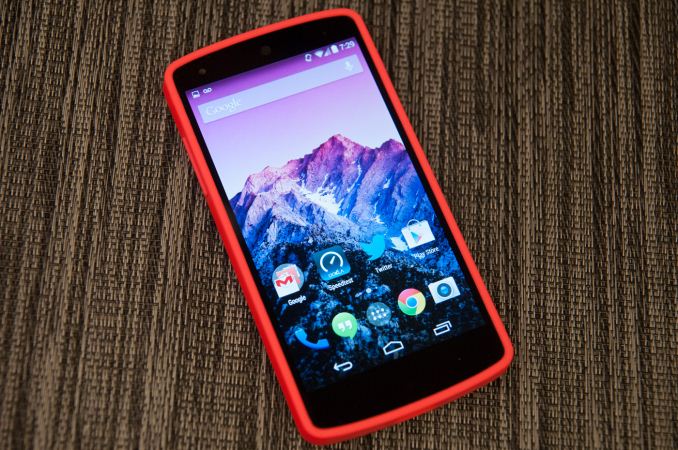








231 Comments
View All Comments
hamiltenor - Thursday, December 5, 2013 - link
Great review, I avoid The Verge like the plague lately. AnandTech, Ars Technica and to a lesser extent, Tom's Hardware are basically the only useful technology news sites from my point of view.Few typos, but I won't bother complaining. It's clear what you meant and they don't detract from the effort or lengths you went to for this review.
Looking forward to the line-out audio comparison!
cheinonen - Thursday, December 5, 2013 - link
I'm working on the article as fast as I can. I had to get another sample of a phone to verify something but I believe I have enough data to write it now. It's just big so it'll take a few days possibly. Lots of work to get done but it's coming ASAP.hrrmph - Thursday, December 5, 2013 - link
I will add to others comments that waiting for you guys to get it right is totally worth it. In spite of my nitpicks, Brian did great on this review, and I'm glad to hear that you are handling audio as a dedicated project.I am very interested to see what you find on your audio quality investigations, especially since 90% of my audio consumption is now via mobile devices with content as follows:
- 80% are WMA-LossLess rips from redbook CDs;
- 10% mp3-360kbs from Amazon; and
- 5% FLAC 24-bit from various sources (and growing on this one).
Having tried numerous devices, I will comment in advance that I find the BlackBerry Z10 to be great for commuting in a noisy environment (good oomph for cutting through rumble over the car speakers) and the Samsung Note 2 and Samsung S-ATIV seem well refined for quiet environment listening at my desks (home and work).
My point being that the sound "profiles" of these devices may not be perfectly accurate, but nonetheless both have their applications and usefulness.
96 and 192KHz / 24-Bit recordings are gradually making their way into my collection in increasing numbers and I'm really enjoying the sound. So HD-Audio is also an interest, especially for material that can make good use of the bandwidth.
WinPhone 8 generally cannot handle FLAC audio files, thus the Blackberry and Samsung Android are my go-to devices for music now. I use them with Sennheiser, Grado, or B&W cans over my head depending where I am at (home / work / travel).
I occasionally use a Gen 1 Asus Nexus 7 for audio listening - it is okay but clearly isn't as good as the Blackberry and Samsung devices, is on par with Zune, and much improved over the old Sansa devices. Hopefully they further improved the audio quality in the Gen 2 device, although I will skip it for other reasons.
The Z10 has excellent volume, while the Note 2 is too quiet in the car on some songs... thus indicating that some devices need supplementary amplification to reach satisfying volume on some songs. Hopefully sound volume issues will get addressed in future mobile devices.
Impulses - Friday, December 6, 2013 - link
Looking forward to this.Alpeshkh - Thursday, December 5, 2013 - link
Ah, should've curbed my excitement and read the display section fory that PSR thing!cgalyon - Thursday, December 5, 2013 - link
Could the camera performance be significantly improved with use of another camera app? I would be interested in seeing if you could do a comparison of the camera performance in the stock app, Camera Awesome, and VSCO Can. My thinking is that it could give us very valuable information on if the camera experience could in fact be one of the best on Android when provided with capable software. Thanks for the very detailed review!Tetracycloide - Thursday, December 5, 2013 - link
Most of the camera negatives are implemented before an app would be given camera data I think. Will require an OS update. 4.4.1 is supposed to be that OS update so we shouldn't have to wait long.AncientWisdom - Thursday, December 5, 2013 - link
Also VERY interested in this.... We know the problem, question is are third party camera apps the solution?blind2haters - Thursday, December 5, 2013 - link
Dude...the metal ring around the lens IS for magnetic lenses... It has already been tested and confirmed. Great research...not.Brian Klug - Thursday, December 5, 2013 - link
Nope. http://cl.ly/image/0o2a2d342R0oEntirely cosmetic at this point.
-Brian